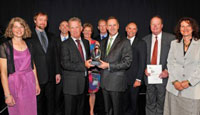 Uncertainties attend the predictions of climate science, as the scientists themselves are careful to acknowledge. Reluctant policy makers use this uncertainty to support a “wait and see” response to climate change. Prominent American economists Gernot Wagner and Martin Weitzman in their recent book Climate Shock: The Economic Consequences of a Hotter Planet are scathing in their condemnation of such a response. They translate “wait and see” as “give up and fold” and call it wilful blindness.
Uncertainties attend the predictions of climate science, as the scientists themselves are careful to acknowledge. Reluctant policy makers use this uncertainty to support a “wait and see” response to climate change. Prominent American economists Gernot Wagner and Martin Weitzman in their recent book Climate Shock: The Economic Consequences of a Hotter Planet are scathing in their condemnation of such a response. They translate “wait and see” as “give up and fold” and call it wilful blindness.
Their own response to the uncertainty surrounding climate predictions is to ask what the worst case scenario looks like.
Here’s what you get: about a 10 percent chance of eventual temperatures exceeding 6 ° C, unless the world acts much more decisively than it has.
This isn’t a figure they’ve made up for themselves. It’s based on IPCC prediction ranges and on the International Energy Agency’s interpretation of current government commitments.
It’s clearly a catastrophic scenario, but with a 10 percent chance of happening it must play a prominent part in our thinking and planning. We take out fire insurance on our homes with a much lower than 10 percent chance of their burning down. It’s called prudence, and most of us don’t think twice about the precaution of insurance.

 This year’s NZ Prime Minister’s Science Prize — worth $500,000 — has been
This year’s NZ Prime Minister’s Science Prize — worth $500,000 — has been  A valuable review,
A valuable review, 